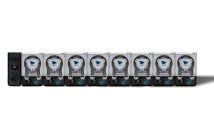Recently, I made a switch from Seachem’s Aqua Vitro Salinity salt mix to the new Fluval SEA. The move wasn’t because I had any issues with the Aqua Vitro brand, other than a little cloudiness and leftover residue from time to time, but purely out of convenience because the closest fish store only had a bucket of the Fluval product and a water change was quickly coming up on my schedule. Since I’ve already gotten to try out the Fluval SEA salt in the past and was quite pleased with it, there was no issue in my mind in making the switch. After getting everything prepped for a sizable water change with the new salt, the thought of all of the different brands of aquarium salt mixes that I’ve used throughout the years immediately popped into my mind. The list includes at least a dozen different products from a variety of brands, that I can remember, and in my pondering I realized that I never had any real complaints about any of the salts that I’ve used. Then I started to think that perhaps the brand of salt you use in your aquarium doesn’t even remotely matter, especially if aquarists are doing any amount of additive dosing.
People all over this hobby have been using budget-friendly, mid-level, and high end salts for decades, and while some folks swear by a specific brand, there’s no general consensus that one salt mix is significantly better than any of the rest (at least in the court of public opinion), regardless of price and name recognition. Each brand has its own selling points, with some touting high calcium or magnesium levels and others boasting favorable dissolution rates, among many others. Either way, hobbyists generally stick to a brand because of one specific detail that makes it seemingly ideal for their setup, and others stick to brands just because that’s what they’ve using for such long time. There’s even an interesting group of hobbyists that buys more than one brand of salt at a time and mixes them in specific proportions so that they can receive the benefits of multiple salt products.
Despite buying a product based specifically on its composition, aquarium keepers still rely heavily on external sources for things like calcium, magnesium, and other beneficial chemical compounds. We also rely on filter media and aquarium equipment to remove nitrate and phosphate from the water, which is also accomplished by a water change made with a decent quality salt mix. In a nutshell, the dosing schemes and filtration methods almost render the brand of the salt mix useless, at least when it comes to picking a brand based on its calcium content, for example. What does it matter what brand name you use when you’re running a calcium reactor 24/7?
That said, the only time I could really think it would matter what brand of salt a hobbyist is using is if they are trying to accomplish something very specific, such as taking on the ZEOvit dosing methods. In that scheme, the idea is to mimic natural seawater conditions, and salts with high calcium and alkalinity are not ideal. Other than that, there’s really no reason to stay loyal to a certain brand.
Now, I’m not suggesting that you ditch your current brand and go with the cheapest offered. Instead, we’re just offering up a very general discussion about an observation that may help some aquarium keepers make up their mind between two different salts, assuming they are on the fence and can’t decide. In the short term, the brand of salt might make a big difference in some aspects of your aquarium, but in the grand scheme of things, is there enough of a difference to justify buying a specific brand?







Pingback: The AquaNerd Weekly Recap | AquaNerd()